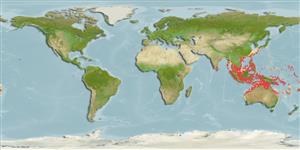>
Eupercaria/misc (Various families in series Eupercaria) >
Labridae (Wrasses)
Etymology: Xiphocheilus: Greek, xiphos = sword + Greek, cheilos = lip (Ref. 45335).
More on author: Bleeker.
Environment: milieu / climate zone / depth range / distribution range
Ecologie
marien; brak water rifbewoner; diepte 15 - 85 m (Ref. 9823). Tropical
Western Pacific: extending into the Indian Ocean only in an area to the west of the Malay Peninsula (Ref. 9823). Recorded from North West Shelf, Australia; Indo-Australian Archipelago (Ref. 3132).
Grootte / Gewicht / Leeftijd
Maturity: Lm ? range ? - ? cm
Max length : 12.0 cm SL mannelijk / geslacht onbekend; (Ref. 9823)
Dorsale stekels (totaal): 12; Dorsale zachte stralen (totaal): 8; Anale stekels 3; Anale zachte stralen: 10
Lives on flat sandy bottoms or rubble (Ref. 3132). Often taken by trawlers but still occassionally seen near reefs. Found solitary or in small groups (Ref. 90102). Minimum depth reported from Ref. 90102.
Levenscyclus en paargedrag
Maturiteit | Voortplanting | Paaien | Eieren | Fecunditeit | Larven
Oviparous, distinct pairing during breeding (Ref. 205).
Westneat, M.W., 2001. Labridae. Wrasses, hogfishes, razorfishes, corises, tuskfishes. p. 3381-3467. In K.E. Carpenter and V. Niem (eds.) FAO species identification guide for fishery purposes. The living marine resources of the Western Central Pacific. Vol. 6. Bony fishes part 4 (Labridae to Latimeriidae), estuarine crocodiles. FAO, Rome. (Ref. 9823)
Status op de Rode Lijst van het IUCN (Ref. 130435)
Gevaar voor de mens
Harmless
Gebruik door de mens
Visserij: van minder commercieel belang
Meer informatie
ReferentiesAquacultuurAquacultuurprofielKweeklijnenGeneticaElectrophoresesErfelijkheidZiektesVerwerkingNutrientsMassaconversie
Tools
Speciale rapporten
Download XML
Internetbronnen
Estimates based on models
Preferred temperature (Ref.
123201): 24.3 - 28.6, mean 27.7 °C (based on 538 cells).
Fylogenetische diversiteitsindex (Ref.
82804): PD
50 = 1.0000 [Uniqueness, from 0.5 = low to 2.0 = high].
Bayesian length-weight: a=0.00955 (0.00456 - 0.02002), b=3.06 (2.89 - 3.23), in cm total length, based on LWR estimates for this (Sub)family-body shape (Ref.
93245).
Trofisch niveau (Ref.
69278): 3.4 ±0.4 se; based on size and trophs of closest relatives
Generation time: 1.4 ( na - na) years. Estimated as median ln(3)/K based on 1
growth studies.
Weerstandsvermogen (Ref.
120179): Hoog, minimale populatieverdubbelingstijd minder dan 15 maanden (K=0.7).
Fishing Vulnerability (Ref.
59153): Low vulnerability (18 of 100).
Nutrients (Ref.
124155): Calcium = 97 [57, 184] mg/100g; Iron = 0.794 [0.453, 1.459] mg/100g; Protein = 18.7 [15.8, 20.9] %; Omega3 = 0.202 [0.119, 0.337] g/100g; Selenium = 27.5 [14.6, 56.0] μg/100g; VitaminA = 131 [35, 557] μg/100g; Zinc = 2.03 [1.37, 3.27] mg/100g (wet weight);
